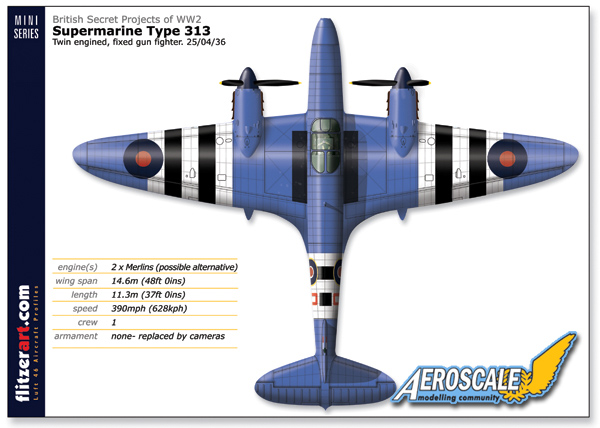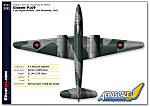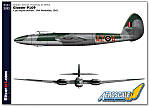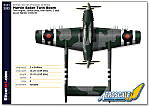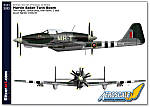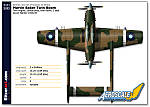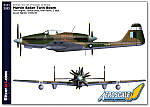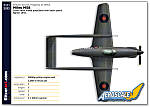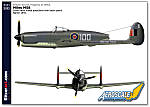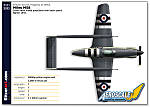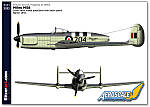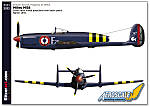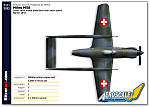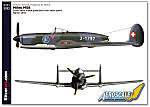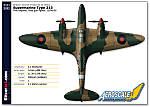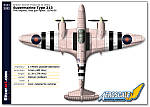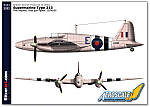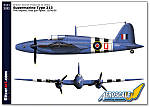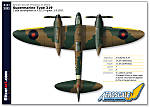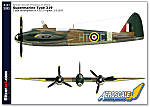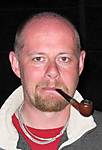British Secret Projects of WW2 Volume 3
12
Comments
Hello again. Another mixed bag of secret project designs; the third volume of British WW2 designs.
Gloster P.109 4 Jet Bomber
In August 1942, Gloster’s George Carter produced a design for a 4 jet bomber simply known as the Gloster Jet Bomber. This was the first British design for a bomber using jet power. Carter explained this was an on-going project and subsequently completed drawings for the improved and revised design P.190 in November the same year..
The P.190 looked like a very large Meteor, with a similar layout. The 4 Whittle W2B jets where housed in common nacelles mid wing. Each pair of engines shared a common intake and a common exhaust slot. Carter thought this design was probably the best that could be arrived at using the W2Bs. Six engines were also considered for the design but of course the weight would have increased.
Martin Baker Twin Boom Fighter
Martin Baker produced this handsome design for a twin engined, twin boom fighter around the end of 1944/early 1945. It is not known if the design was given a project number, and is known simply as the Twin Boom. The design was to use two Griffon power units housed one at each end of the cigar shaped fuselage, each Griffon powering a pair of 3-blade contra rotating props. Construction methods and design would probably have followed that of the MB5.
The crew of two was housed in slightly staggered twin side-by-side cockpits.
Miles M22
In 1941 Miles submitted this design to the Air Ministry hoping to use the Rolls Royce Griffon engine (1,600hp) that was just then becoming available.
Miles envisaged an extremely clean design that promised a much higher performance than anything produced thus far (150mph faster than the contemporary Spitfire and 100mph faster than the Mosquito).
The Miles M22 was to be of all-wooden construction except for metal wing spars, featuring a one piece low aspect elliptical plan wing. As there was not any fuselage clearance problems the two engines and props could be mounted much closer to the centre line, improving single engined performance and reducing take-off engine-cut effect..
The one problem with the design was that of pilot view. With this in mind it was proposed that the seat could be raised by 1 foot and the pilot would sit with his head outside and above the cockpit roof during take off and landing..
Armament was to be housed in the leading edge of the wing centre or a ten gun bullet shaped nacelle placed ahead of the cockpit..
Miles M58
In 1945 Miles came up with this twin boom design for a very small and light weight Naval patrol fighter using mixed piston/jet power units. A small piston engine driving a 3-blade propeller was mounted in the fuselage nose with the jet housed in the rear. The idea was that once airborne the jet could be shut down allowing the M58 to cruise around on patrol at low speed for up to seven hours duration, the jet engine then being called upon for combat.
Although nothing came of the design it was deemed to have merit. If it had been put into production it may have taken sales away from the DH Vampire. With this in mind I have done a few profiles of the M58 in the colours of countries that had Vampires in service after WW2.
Supermarine Type 313
A twin engined project using a pair of Rolls Royce Goshawk engines or Aero Engines Ltd (Hispano) 12Ys. The design saw the radiators buried in the lower inner wing, fed by small slot inlets under the leading edges. A battery of four 20mm cannon was housed in the nose. The design was very clean and tidy that would have promised a comparative high speed. The Goshawks may have proved too much ‘long in the tooth’ by the time it may have reached production and many think it probably would have had these replaced with Merlins, or Peregrines as used by the Westland Whirlwind..
The profile in the earth/dark green camouflage depicts the earlier engine choice, while the two proposed photo-recon versions show Merlins.
Supermarine Type 319
This was a two seat development of the F.11/37 fighter using a pair of Vulture 8.37 engines. The design had a streamlined fuselage and engine nacelles..
Armament consisted of two guns mounted in the lower nose firing forward and two mounted in the upper fuselage just aft of the cockpit firing at an oblique angle off 65 degrees. This technique was first tried during WW1 and later adopted by the Luftwaffe in later WW2 designs known as ‘Schrage Musik’.
Special Thanks Sincere thanks to all the Secret Projects site members who contributed, with special gratitude to Mr Justo Miranda for endless streams of references, expert advice and suggestions.
References
The following references proved invaluable in helping me to produce these profiles.
Those provided by Mr Justo Miranda, Jemiba and many others..
And the excellent book British Secret Projects. Fighters and Bombers 1935-1950 by Tony Buttler.
That’s it for now. More coming.
Gloster P.109 4 Jet Bomber
In August 1942, Gloster’s George Carter produced a design for a 4 jet bomber simply known as the Gloster Jet Bomber. This was the first British design for a bomber using jet power. Carter explained this was an on-going project and subsequently completed drawings for the improved and revised design P.190 in November the same year..
The P.190 looked like a very large Meteor, with a similar layout. The 4 Whittle W2B jets where housed in common nacelles mid wing. Each pair of engines shared a common intake and a common exhaust slot. Carter thought this design was probably the best that could be arrived at using the W2Bs. Six engines were also considered for the design but of course the weight would have increased.
Martin Baker Twin Boom Fighter
Martin Baker produced this handsome design for a twin engined, twin boom fighter around the end of 1944/early 1945. It is not known if the design was given a project number, and is known simply as the Twin Boom. The design was to use two Griffon power units housed one at each end of the cigar shaped fuselage, each Griffon powering a pair of 3-blade contra rotating props. Construction methods and design would probably have followed that of the MB5.
The crew of two was housed in slightly staggered twin side-by-side cockpits.
Miles M22
In 1941 Miles submitted this design to the Air Ministry hoping to use the Rolls Royce Griffon engine (1,600hp) that was just then becoming available.
Miles envisaged an extremely clean design that promised a much higher performance than anything produced thus far (150mph faster than the contemporary Spitfire and 100mph faster than the Mosquito).
The Miles M22 was to be of all-wooden construction except for metal wing spars, featuring a one piece low aspect elliptical plan wing. As there was not any fuselage clearance problems the two engines and props could be mounted much closer to the centre line, improving single engined performance and reducing take-off engine-cut effect..
The one problem with the design was that of pilot view. With this in mind it was proposed that the seat could be raised by 1 foot and the pilot would sit with his head outside and above the cockpit roof during take off and landing..
Armament was to be housed in the leading edge of the wing centre or a ten gun bullet shaped nacelle placed ahead of the cockpit..
Miles M58
In 1945 Miles came up with this twin boom design for a very small and light weight Naval patrol fighter using mixed piston/jet power units. A small piston engine driving a 3-blade propeller was mounted in the fuselage nose with the jet housed in the rear. The idea was that once airborne the jet could be shut down allowing the M58 to cruise around on patrol at low speed for up to seven hours duration, the jet engine then being called upon for combat.
Although nothing came of the design it was deemed to have merit. If it had been put into production it may have taken sales away from the DH Vampire. With this in mind I have done a few profiles of the M58 in the colours of countries that had Vampires in service after WW2.
Supermarine Type 313
A twin engined project using a pair of Rolls Royce Goshawk engines or Aero Engines Ltd (Hispano) 12Ys. The design saw the radiators buried in the lower inner wing, fed by small slot inlets under the leading edges. A battery of four 20mm cannon was housed in the nose. The design was very clean and tidy that would have promised a comparative high speed. The Goshawks may have proved too much ‘long in the tooth’ by the time it may have reached production and many think it probably would have had these replaced with Merlins, or Peregrines as used by the Westland Whirlwind..
The profile in the earth/dark green camouflage depicts the earlier engine choice, while the two proposed photo-recon versions show Merlins.
Supermarine Type 319
This was a two seat development of the F.11/37 fighter using a pair of Vulture 8.37 engines. The design had a streamlined fuselage and engine nacelles..
Armament consisted of two guns mounted in the lower nose firing forward and two mounted in the upper fuselage just aft of the cockpit firing at an oblique angle off 65 degrees. This technique was first tried during WW1 and later adopted by the Luftwaffe in later WW2 designs known as ‘Schrage Musik’.
Special Thanks Sincere thanks to all the Secret Projects site members who contributed, with special gratitude to Mr Justo Miranda for endless streams of references, expert advice and suggestions.
References
The following references proved invaluable in helping me to produce these profiles.
Those provided by Mr Justo Miranda, Jemiba and many others..
And the excellent book British Secret Projects. Fighters and Bombers 1935-1950 by Tony Buttler.
That’s it for now. More coming.
Comments
Hi Jean Luc
I sort of did the French Miles with you in mind. Glad you like it.
Scratch build?
Cheers
Peter
DEC 15, 2008 - 08:09 PM
A very nice job Peter, like as usual !!!!
The Miles M22 particulary is a real beauty !!!!
Have you contact with Igor from Unicraft, i have find a lot of your work is the future releases?
DEC 16, 2008 - 01:13 AM
Peter. Lovely stuff, like most you do. I guess we would all appreciate if you went to the local horce races, won £100000, got yourself a powerful cadsystem and SLS-3d printing equipment and put the stuff on the market. Any scale is possible, so it would be a brave new world.
DEC 16, 2008 - 01:28 AM
Hi and many thanks.
Jengel
Yes I know Igor quite well and I'm happy he uses a few of my images.
Igor has made a few especially exciting choices this time I think.
Tony
I have toyed with the idea of doing 3D illustrations for ages but as you say its the software costs and then the practice. I will one day.
At present I use the mouse/Photoshop brush like a real brush, as close to reality as possible I suppose. It's called age I think .
Many thanks again and more coming.
Peter
DEC 16, 2008 - 04:11 AM
Hello Peter,
Do you know if the Miles M22 is plan to be mold . (specially without the ugly nacelle placed ahead of the cockpit..just not my tast!!!) ??
DEC 16, 2008 - 04:40 AM
Hi Jengel.
I don't know if Igor is planning the M22.
I will drop him a line and ask.
Even I might come out of the modelling twilight zone for that one.
Cheers
Peter
DEC 16, 2008 - 08:24 PM
An absolutely fantastic set of images, Peter! Your attention to detail is impeccable. I'm quite taken by the Miles M.22 as well. If someone kits it, I'll be first in line. If not, i may scratch build it. Either way, would you mind if I used your markings, as homage to your fine artistry? Thanks!
DEC 16, 2008 - 08:34 PM
Hi Alex
Many thanks for your kind comments.
Absolutely not.
Please go ahead.
This profile thing was initially started as a camo/markings ideas guide for modellers trying secret project/prototype aircraft.
So please be my guest.
Many thanks again
Peter
DEC 16, 2008 - 10:02 PM
Hi Jengel
Just e-mailed Igor.
He had not seen the Miles M22 before, so I sent him pics of the profile.
He immediately came back with.....expect the Miles M22 kit sometime in 2009.
He loves the thing.
However it will more than likely be 1/72nd scale, not 1/48th.
So watch Unicraft for further developments.
He's got a start, he has the box art already...
Cheers
Peter
DEC 17, 2008 - 01:10 AM
God bless you Pete
You and Igor are the guarantee that i have always something original to modeling in the futur
I wait this one !!!!!
Thank again,
Jérôme
DEC 17, 2008 - 03:02 AM
Copyright ©2021 by Peter Allen. Images also by copyright holder unless otherwise noted. The views and opinions expressed herein are solely the views and opinions of the authors and/or contributors to this Web site and do not necessarily represent the views and/or opinions of AeroScale, KitMaker Network, or Silver Star Enterrpises. Images also by copyright holder unless otherwise noted. Opinions expressed are those of the author(s) and not necessarily those of AeroScale. All rights reserved. Originally published on: 2008-12-12 00:00:00. Unique Reads: 31622




